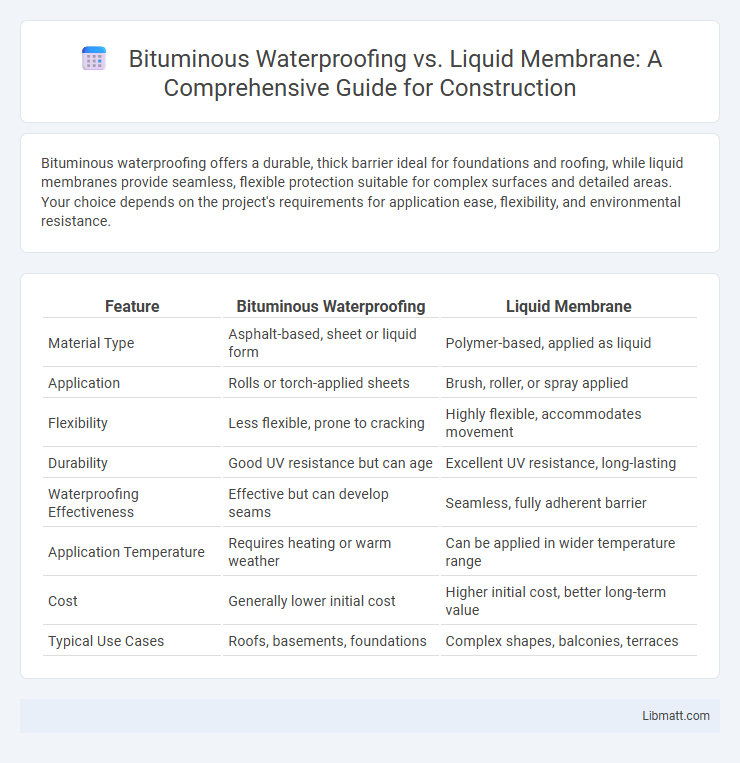Bituminous waterproofing offers a durable, thick barrier ideal for foundations and roofing, while liquid membranes provide seamless, flexible protection suitable for complex surfaces and detailed areas. Your choice depends on the project's requirements for application ease, flexibility, and environmental resistance.
Table of Comparison
| Feature | Bituminous Waterproofing | Liquid Membrane |
|---|---|---|
| Material Type | Asphalt-based, sheet or liquid form | Polymer-based, applied as liquid |
| Application | Rolls or torch-applied sheets | Brush, roller, or spray applied |
| Flexibility | Less flexible, prone to cracking | Highly flexible, accommodates movement |
| Durability | Good UV resistance but can age | Excellent UV resistance, long-lasting |
| Waterproofing Effectiveness | Effective but can develop seams | Seamless, fully adherent barrier |
| Application Temperature | Requires heating or warm weather | Can be applied in wider temperature range |
| Cost | Generally lower initial cost | Higher initial cost, better long-term value |
| Typical Use Cases | Roofs, basements, foundations | Complex shapes, balconies, terraces |
Introduction to Bituminous Waterproofing and Liquid Membrane
Bituminous waterproofing uses asphalt-based materials to create a durable, flexible barrier ideal for roofing and foundation protection against water infiltration. Liquid membrane waterproofing involves applying a seamless, elastomeric coating that forms a flexible, watertight layer adapting to structural movements. Your choice between these methods depends on project requirements such as durability, flexibility, and ease of application.
What is Bituminous Waterproofing?
Bituminous waterproofing is a durable, asphalt-based material widely used for protecting roofs, basements, and foundations from water infiltration. It forms a thick, sticky layer that adheres strongly to surfaces, providing excellent resistance against moisture, UV radiation, and weathering. This method is favored in construction due to its cost-effectiveness, ease of application, and long-lasting waterproofing performance.
What is Liquid Membrane Waterproofing?
Liquid membrane waterproofing involves applying a seamless, flexible coating that transforms into a rubber-like barrier upon drying, effectively preventing water infiltration. This method uses polymer-based liquids such as polyurethane, acrylic, or bitumen emulsions, which adapt to complex surfaces and provide excellent adhesion, elasticity, and durability. Compared to bituminous waterproofing, liquid membranes offer superior crack-bridging properties and can be easily applied to vertical and horizontal structures, ensuring comprehensive protection against moisture.
Material Composition: Bituminous vs. Liquid Membrane
Bituminous waterproofing consists of asphalt-based compounds reinforced with fiberglass or polyester mats, offering robust durability and resistance to water penetration. Liquid membranes are typically composed of polymer-based materials like polyurethane or acrylic, allowing for flexible, seamless application that adapts to irregular surfaces. Choosing between bituminous and liquid membranes depends on your project's specific needs for material flexibility, adhesion, and environmental exposure.
Application Methods Compared
Bituminous waterproofing involves the application of hot or cold bitumen-based sheets that are torched or self-adhered onto surfaces, providing a thick, durable barrier against moisture. Liquid membranes are applied as a liquid coating using brushes, rollers, or spray equipment, forming a seamless, flexible film that adapts easily to irregular shapes and cracks. Your choice between these methods depends on factors like surface type, ease of application, and desired waterproofing flexibility.
Durability and Longevity of Both Systems
Bituminous waterproofing offers high durability with resistance to UV rays and mechanical damage, typically lasting 10 to 20 years depending on environmental factors. Liquid membrane systems provide excellent flexibility and seamless coverage, often extending lifespan beyond 20 years when properly applied and maintained. Your choice should consider exposure conditions and maintenance capabilities to ensure long-term waterproofing performance.
Key Benefits of Bituminous Waterproofing
Bituminous waterproofing offers exceptional durability and excellent resistance to water infiltration, making it ideal for protecting foundations, roofs, and basements. Its ease of application and cost-effectiveness provide a reliable solution for long-term moisture protection. Choosing this method ensures your structure benefits from robust performance against harsh weather conditions and chemical exposure.
Advantages of Liquid Membrane Solutions
Liquid membrane waterproofing offers superior flexibility and seamless application, ensuring effective protection against water infiltration even on irregular or complex surfaces. Its quick curing time and UV resistance enhance durability, making it ideal for both new construction and renovation projects. The environmentally friendly formulations and ease of maintenance further position liquid membranes as a sustainable and cost-effective choice over traditional bituminous solutions.
Cost Comparison: Bituminous vs. Liquid Membrane
Bituminous waterproofing generally offers a lower initial cost compared to liquid membrane solutions, making it a budget-friendly option for large-scale applications. Liquid membranes, while more expensive upfront, provide superior elasticity and seamless coverage, reducing long-term maintenance expenses. Total cost considerations must include installation labor, material durability, and project-specific requirements to determine the best waterproofing investment.
Choosing the Right Waterproofing Method for Your Project
Bituminous waterproofing offers durable protection with excellent adhesion and flexibility, making it ideal for roofing and below-grade structures requiring long-lasting moisture barriers. Liquid membranes provide seamless application and superior adaptability to complex shapes, ensuring effective waterproofing in areas with intricate detailing or irregular surfaces. Selecting the right method depends on project specifications, substrate type, environmental conditions, and budget considerations to achieve optimal performance and durability.
Bituminous waterproofing vs liquid membrane Infographic

 libmatt.com
libmatt.com